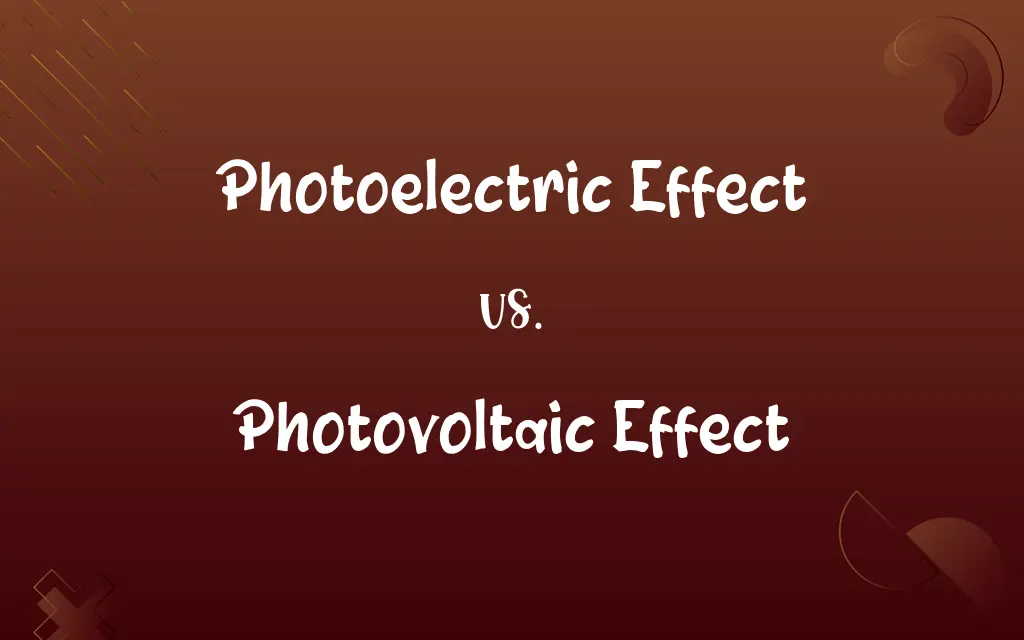Photoelectric Effect vs. Photovoltaic Effect: Know the Difference

By Shumaila Saeed || Updated on December 25, 2023
The Photoelectric Effect involves the emission of electrons from a material when light is absorbed, while the Photovoltaic Effect generates voltage or electric current in a material upon exposure to light.

Key Differences
The Photoelectric Effect refers to the phenomenon where electrons are emitted from a material, typically a metal, when it absorbs light or electromagnetic radiation. Albert Einstein famously explained this effect, which contributed to quantum theory. The Photovoltaic Effect, on the other hand, occurs when light is absorbed by a semiconductor material, creating voltage or electrical current. This effect is the working principle behind solar cells and solar panels.
Shumaila Saeed
Dec 17, 2023
In the Photoelectric Effect, the energy of the incoming light must be greater than the work function of the material for electrons to be emitted. This effect is instantaneous and depends on the frequency of the incident light, not its intensity. The Photovoltaic Effect differs in that it converts light energy directly into electrical energy and is used in solar power technology. Here, the intensity of light can influence the amount of electric current generated.
Shumaila Saeed
Dec 17, 2023
The Photoelectric Effect has been crucial in the development of quantum mechanics, demonstrating the particle nature of light. It showed that light could be thought of as quanta of energy, or photons, each with a specific energy level. The Photovoltaic Effect has had a significant impact on renewable energy technologies, enabling the conversion of sunlight into electricity, which is key for solar power generation.
Shumaila Saeed
Dec 17, 2023
Applications of the Photoelectric Effect include in photocells and light meters, where the emitted electrons are used to measure light intensity or create an electrical signal. The Photovoltaic Effect is predominantly used in the creation of solar panels and solar cells, which are essential components in harnessing solar energy for electricity generation in residential and commercial applications.
Shumaila Saeed
Dec 17, 2023
The Photoelectric Effect requires a vacuum or gas-filled tube for the observation and measurement of emitted electrons, whereas the Photovoltaic Effect is observed in solid-state devices, like solar cells, where a junction of two different types of semiconductors is typically used.
Shumaila Saeed
Dec 17, 2023
ADVERTISEMENT
Comparison Chart
Basic Principle
Emission of electrons from materials by light
Generation of voltage/current from light in materials
Shumaila Saeed
Dec 17, 2023
Key Discovery
Particle nature of light
Direct conversion of light to electricity
Shumaila Saeed
Dec 17, 2023
Dependency
Depends on light frequency, not intensity
Intensity of light affects current generation
Shumaila Saeed
Dec 17, 2023
Material & Configuration
Metals, vacuum or gas-filled tubes
Semiconductor materials, solid-state devices
Shumaila Saeed
Dec 17, 2023
ADVERTISEMENT
Photoelectric Effect and Photovoltaic Effect Definitions
Photoelectric Effect
A process where photons cause electron ejection.
Photons must have sufficient energy to trigger the photoelectric effect.
Shumaila Saeed
Dec 11, 2023
Photovoltaic Effect
The generation of voltage from light exposure.
The photovoltaic effect is fundamental in solar energy technology.
Shumaila Saeed
Dec 11, 2023
Photoelectric Effect
A quantum phenomenon where light dislodges electrons.
Einstein's explanation of the photoelectric effect supported the quantum theory.
Shumaila Saeed
Dec 11, 2023
Photovoltaic Effect
The creation of electrical current by solar radiation.
Solar calculators operate based on the photovoltaic effect.
Shumaila Saeed
Dec 11, 2023
Photoelectric Effect
Emission of electrons from a material when exposed to light.
The photoelectric effect explains how old-style light meters work.
Shumaila Saeed
Dec 11, 2023
ADVERTISEMENT
Photovoltaic Effect
Conversion of light into electricity in semiconductors.
Solar panels use the photovoltaic effect to generate power.
Shumaila Saeed
Dec 11, 2023
Photoelectric Effect
The release of electrons by electromagnetic radiation.
The photoelectric effect demonstrates the particle nature of light.
Shumaila Saeed
Dec 11, 2023
Photovoltaic Effect
Direct conversion of sunlight into electrical energy.
Rooftop solar cells utilize the photovoltaic effect.
Shumaila Saeed
Dec 11, 2023
Photoelectric Effect
Light-induced electron emission from a substance.
The photoelectric effect is observed in photocells.
Shumaila Saeed
Dec 11, 2023
Photovoltaic Effect
Light-induced electric current production in materials.
The photovoltaic effect makes solar-powered devices possible.
Shumaila Saeed
Dec 11, 2023
Repeatedly Asked Queries
What is the Photoelectric Effect?
The Photoelectric Effect is the emission of electrons from a material when it is exposed to light or electromagnetic radiation.
Shumaila Saeed
Dec 17, 2023
What is the threshold frequency in the Photoelectric Effect?
The threshold frequency is the minimum frequency of light required to initiate the Photoelectric Effect for a particular material.
Shumaila Saeed
Dec 17, 2023
Who discovered the Photoelectric Effect?
Albert Einstein's explanation of the Photoelectric Effect in 1905 played a significant role in its understanding.
Shumaila Saeed
Dec 17, 2023
What materials are commonly used in photovoltaic cells?
Silicon-based materials are most commonly used in photovoltaic cells, but other materials like cadmium telluride (CdTe) and thin-film materials are also used.
Shumaila Saeed
Dec 17, 2023
What causes the Photoelectric Effect?
The Photoelectric Effect is caused by the interaction of photons (light particles) with electrons in a material, leading to their ejection.
Shumaila Saeed
Dec 17, 2023
What is the significance of the Photoelectric Effect?
The Photoelectric Effect provided experimental evidence for the particle-like nature of light (photons) and contributed to the development of quantum mechanics.
Shumaila Saeed
Dec 17, 2023
What is the Photovoltaic Effect?
The Photovoltaic Effect is the generation of electricity when certain materials (usually semiconductors) are exposed to light.
Shumaila Saeed
Dec 17, 2023
How do solar panels work based on the Photovoltaic Effect?
Solar panels use the Photovoltaic Effect to convert sunlight into electricity by harnessing the energy of photons to generate an electric current.
Shumaila Saeed
Dec 17, 2023
How does the Photoelectric Effect differ from the Photovoltaic Effect?
The Photoelectric Effect involves the emission of electrons when light strikes a material, while the Photovoltaic Effect generates electricity from light exposure.
Shumaila Saeed
Dec 17, 2023
Who discovered the Photovoltaic Effect?
Alexandre-Edmond Becquerel is credited with discovering the Photovoltaic Effect in 1839.
Shumaila Saeed
Dec 17, 2023
Can the Photoelectric Effect be harnessed for sustainable energy production?
While the Photoelectric Effect is not directly used for energy production, its principles contribute to our understanding of energy conversion processes and can inform sustainable technologies like photovoltaics.
Shumaila Saeed
Dec 17, 2023
Is the Photovoltaic Effect environmentally friendly?
The Photovoltaic Effect is considered environmentally friendly as it produces clean, renewable energy without greenhouse gas emissions.
Shumaila Saeed
Dec 17, 2023
Are both effects related to the interaction of light and materials?
Yes, both effects are related to the interaction of light with materials, but they have different outcomes: the Photoelectric Effect releases electrons, while the Photovoltaic Effect produces electrical current.
Shumaila Saeed
Dec 17, 2023
What type of energy conversion occurs in the Photoelectric Effect?
In the Photoelectric Effect, light energy is converted into kinetic energy of emitted electrons.
Shumaila Saeed
Dec 17, 2023
Is the Photoelectric Effect environmentally friendly?
The Photoelectric Effect itself does not have a significant environmental impact since it involves the emission of electrons. However, it plays a role in understanding the behavior of light and electrons.
Shumaila Saeed
Dec 17, 2023
Can the Photoelectric Effect be used for power generation like the Photovoltaic Effect?
The Photoelectric Effect is not typically used for power generation, whereas the Photovoltaic Effect is the basis for solar power generation.
Shumaila Saeed
Dec 17, 2023
What are the practical applications of the Photovoltaic Effect?
The Photovoltaic Effect is widely applied in solar panels and solar cells for electricity generation in residential, commercial, and industrial settings.
Shumaila Saeed
Dec 17, 2023
What type of energy conversion occurs in the Photovoltaic Effect?
The Photovoltaic Effect converts light energy (photons) into electrical energy (electric current).
Shumaila Saeed
Dec 17, 2023
What is the efficiency of photovoltaic cells?
The efficiency of photovoltaic cells varies but can range from 15% to 25% or more, depending on the technology and materials used.
Shumaila Saeed
Dec 17, 2023
What are some practical applications of the Photoelectric Effect?
The Photoelectric Effect is used in devices like photomultiplier tubes and photodetectors for scientific and industrial purposes.
Shumaila Saeed
Dec 17, 2023
Share this page
Link for your blog / website
HTML
Link to share via messenger
About Author
Written by
Shumaila SaeedShumaila Saeed, an expert content creator with 6 years of experience, specializes in distilling complex topics into easily digestible comparisons, shining a light on the nuances that both inform and educate readers with clarity and accuracy.









































































